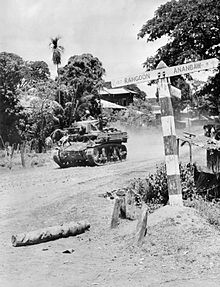The 11th Army Group was the main British Army force in Southeast Asia during the Second World War. Although a nominally British formation, it also included large numbers of troops and formations from the British Indian Army and from British African colonies, and also Nationalist Chinese and United States units.

The British Fourteenth Army was a multi-national force comprising units from Commonwealth countries during the Second World War. As well as British Army units, many of its units were from the Indian Army and there were also significant contributions from the British Army's West and East African divisions. It was often referred to as the "Forgotten Army" because its operations in the Burma campaign were overlooked by the contemporary press, and remained more obscure than those of the corresponding formations in Europe for long after the war. For most of the Army's existence, it was commanded by Lieutenant-General William Slim.

The Burma campaign was a series of battles fought in the British colony of Burma. It was part of the South-East Asian theatre of World War II and primarily involved forces of the Allies against the invading forces of the Empire of Japan. Imperial Japan was supported by the Thai Phayap Army, as well as two collaborationist independence movements and armies. Nominally independent puppet states were established in the conquered areas and some territories were annexed by Thailand. In 1942 and 1943, the international Allied force in British India launched several failed offensives to retake lost territories. Fighting intensified in 1944, and British Empire forces peaked at around 1 million land and air forces. These forces were drawn primarily from British India, with British Army forces, 100,000 East and West African colonial troops, and smaller numbers of land and air forces from several other Dominions and Colonies. These additional forces allowed the Allied recapture of Burma in 1945.

The South-East Asian Theatre of World War II consisted of the campaigns of the Pacific War in the Philippines, Thailand, Indonesia, Indochina, Burma, India, Malaya and Singapore between 1941 and 1945.

The Battle of the Admin Box took place on the southern front of the Burma campaign from 5 to 23 February 1944, in the South-East Asian Theatre of World War II.

The concurrent Battle of Meiktila and Battle of Mandalay were decisive engagements near the end of the Burma campaign during World War II. Collectively, they are sometimes referred to as the Battle of Central Burma. Despite logistical difficulties, the Allies were able to deploy large armoured and mechanised forces in Central Burma, and also possessed air supremacy. Most of the Japanese forces in Burma were destroyed during the battles, allowing the Allies to later recapture the capital, Rangoon, and reoccupy most of the country with little organised opposition.

The 17th Infantry Division is a formation of the Indian Army. During the Second World War, it had the distinction of being continually in combat during the three-year-long Burma Campaign. The division was re-raised in 1960 and the 17 Mountain Division is presently located in Sikkim under XXXIII Corps.

The Japanese invasion of Burma was the opening phase of the Burma campaign in the South-East Asian theatre of World War II, which took place over four years from 1942 to 1945. During the first year of the campaign, the Japanese Army drove British Empire and Chinese forces out of Burma, then began the Japanese occupation of Burma and formed a nominally independent Burmese administrative government.

The Burma campaign in the South-East Asian Theatre of World War II took place over four years from 1942 to 1945. During the first year of the campaign, the Imperial Japanese Army with aid from Burmese insurgents had driven British forces and Chinese forces out of Burma, and occupied most of the country. From May to December 1942, most active campaigning ceased as the monsoon rains made tactical movement almost impossible in the forested and mountainous border between India and Burma, and both the Allies and Japanese faced severe logistical constraints.

The fighting in the Burma campaign in 1944 was among the most severe in the South-East Asian Theatre of World War II. It took place along the borders between Burma and India, and Burma and China, and involved the British Commonwealth, Chinese and United States forces, against the forces of Imperial Japan and the Indian National Army. British Commonwealth land forces were drawn primarily from the United Kingdom, British India and Africa.

The Japanese 15th Army was an army of the Imperial Japanese Army during World War II. It was involved in the invasion of Burma in December 1941 and served in that country for most of its war service.
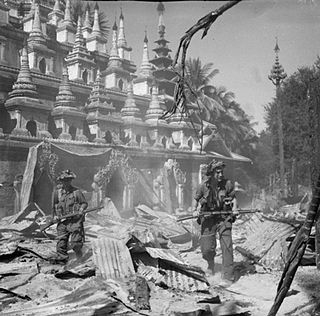
The Burma campaign in the South-East Asian Theatre of World War II was fought primarily by British Commonwealth, Chinese and United States forces against the forces of Imperial Japan, who were assisted by the Burmese National Army, the Indian National Army, and to some degree by Thailand. The British Commonwealth land forces were drawn primarily from the United Kingdom, British India and Africa.
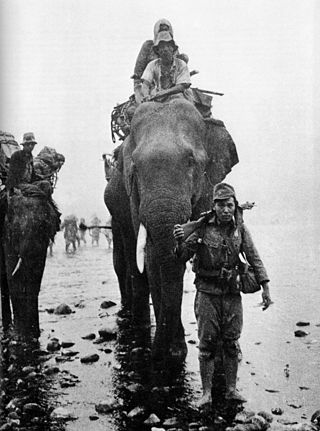
The Japanese Twenty-Eighth Army was an army of the Imperial Japanese Army during the final days of World War II.
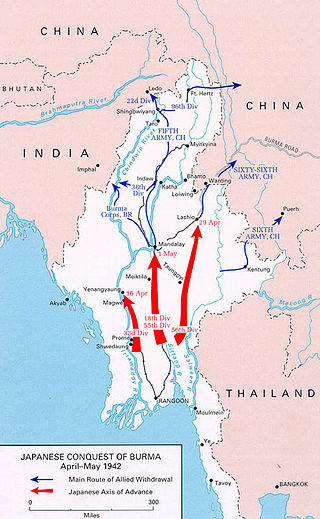
The Battle of Sittang Bridge was part of the Burma campaign during the Second World War. Fought between 22 February and 23 February 1942, the battle was a victory for the Empire of Japan, with many losses for the British Indian Army, which was forced to retreat in disarray. Brigadier Sir John George Smyth, V.C.—who commanded the British Indian Army at Sittang Bridge—called it "the Sittang disaster".
The Battle of Bilin River was the first major battle of the Burma Campaign in World War II. Fought between 14 February 1942 and 19 February 1942, the battle was a tactical victory for Japan over the British Indian Army, and it led to a decisive victory for Japan immediately afterwards at the Battle of Sittang Bridge.
The Taukkyan Roadblock was an engagement in the Burma campaign in World War II. It was an attempt to clear a roadblock held by elements of the Japanese 33rd Division, which was preventing the evacuation of the main force of the Burma Army from Rangoon. After heavy fighting throughout 7 March 1942, and a counterattack that night, the roadblock was taken on the early morning of 8 March, with little resistance. As a result, the Burma Army was able to withdraw northwards unimpeded, and avoid being captured in Rangoon by the Japanese forces.

The Arakan campaign of 1942–1943 was the first tentative Allied attack into Burma, following the Japanese invasion of Burma earlier in 1942, during the Second World War. The British Army and British Indian Army were not ready for offensive actions in the difficult terrain they encountered, nor had the civil government, industry and transport infrastructure of Eastern India been organised to support the Army on the frontier with Burma. Japanese defenders occupying well-prepared positions repeatedly repulsed the British and Indian forces, who were then forced to retreat when the Japanese received reinforcements and counter-attacked.

The XV Corps was a corps-sized formation of the British Indian Army, which was formed in India during the Second World War. It took part in the Burma Campaign and was disbanded after the end of the war. While part of the British Indian Army, it included other commonwealth units, namely the 22nd and 28th East African Brigades.
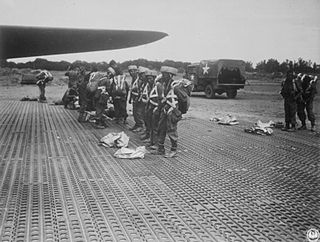
The Battle of Elephant Point was an airborne operation at the mouth of the Rangoon River conducted by a composite Gurkha airborne battalion that took place on 1 May 1945. In March 1945, plans were made for an assault on Rangoon, the capital of Burma, as a stepping-stone on the way to recapturing Malaya and Singapore. Initial plans for the assault on the city had called for a purely land-based approach by British Fourteenth Army, but concerns about heavy Japanese resistance led to this being modified with the addition of a joint amphibious-airborne assault. This assault, led by 26th Indian Division, would sail up the Rangoon River, but before it could do so, the river would have to be cleared of Japanese and British mines. In order to achieve this, coastal defences along the river would have to be neutralized, including a battery at Elephant Point.

The Battle of the Sittang Bend and the Japanese Breakout across Pegu Yomas were linked Japanese military operations during the Burma Campaign, which took place nearly at the end of World War II. Surviving elements of the Imperial Japanese Army who had been driven into the Pegu Yoma attempted to break out eastwards in order to join other Japanese troops retreating from the British forces. The break-out was the objective of the Japanese Twenty-Eighth Army with support at first from the Thirty-Third Army and later the Fifteenth Army. As a preliminary, the Japanese Thirty-Third Army attacked Allied positions in the Sittang Bend, near the mouth of the river, to distract the Allies. The British had been alerted to the break-out attempt and it ended calamitously for the Japanese, who suffered many losses, with some formations being wiped out.

